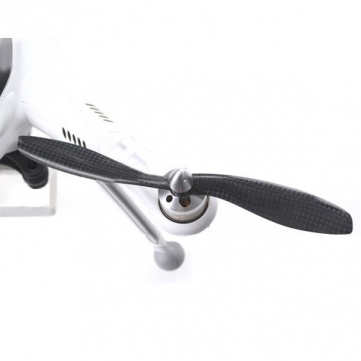Community Tip - You can Bookmark boards, posts or articles that you'd like to access again easily! X
- Community
- Creo+ and Creo Parametric
- 3D Part & Assembly Design
- Re: To make propeller blade
- Subscribe to RSS Feed
- Mark Topic as New
- Mark Topic as Read
- Float this Topic for Current User
- Bookmark
- Subscribe
- Mute
- Printer Friendly Page
To make propeller blade
- Mark as New
- Bookmark
- Subscribe
- Mute
- Subscribe to RSS Feed
- Permalink
- Notify Moderator
To make propeller blade
Hi,
I am trying to make propeller blade in Creo 2.0 using surface and variable section sweep ,but i am not able to apply the pitch to the blade ,it's just coming along the same plane(flat propeller without pitch),it needs to have a twist(pitch), please make a video on how to do it or just give me some suggestions.

I think the problem is that when i draw two lines for the variable section sweep ,i draw them on the same plane but in order to get the pitch ,i need to draw them in such a way that they are not restricted to just one plane ,i don't know how to draw the lines that stretch from one plane to another(parallel) plane ,i.e i need to draw the lines in 3 dimensional space ,how to draw it?
This thread is inactive and closed by the PTC Community Management Team. If you would like to provide a reply and re-open this thread, please notify the moderator and reference the thread. You may also use "Start a topic" button to ask a new question. Please be sure to include what version of the PTC product you are using so another community member knowledgeable about your version may be able to assist.
- Labels:
-
General
- Mark as New
- Bookmark
- Subscribe
- Mute
- Subscribe to RSS Feed
- Permalink
- Notify Moderator
In the VSS, are you using a trajpar or evalgraph statements to change the pitch along the trajectory?
Often times people do have sketch constrains that conflict with the variable parameters in their section. In that case, the feature reverts to non-variable.
- Mark as New
- Bookmark
- Subscribe
- Mute
- Subscribe to RSS Feed
- Permalink
- Notify Moderator
- Mark as New
- Bookmark
- Subscribe
- Mute
- Subscribe to RSS Feed
- Permalink
- Notify Moderator
Hi ,
Thanks but i am still learning so i don't know what 'trajpar or evalgraph' means.
So, i will try to guess what you did.
First you drew a spline of some length, next you used pattern and variable section sweep(i didn't get this part)
you drew the section and swept it along the spline? why pattern? the blades are not positioned the same way right? they are inverted
can you give me the steps you followed after the spline ,if you don't mind?
i got the round and the central cylinder part.
- Mark as New
- Bookmark
- Subscribe
- Mute
- Subscribe to RSS Feed
- Permalink
- Notify Moderator
Trajpar is a very powerful feature in variable sections sweeps. It is a operator that evaluates the position along the "origin" and allows you to use that value in mathematical operations.
The value of trajpar is 0 to 1 for open curves, and 0 to 1 degrees for closed curves.
In the section of the sweep, I am changing the angle of the pitch; reducing the width; and reducing the thickness as it sweeps along the origin.
The pattern is only the second blade.
Can you open the file attached to my earlier message?
You can search documents for trajpar and get more information. A similar powerful function is evalgraph that uses a graph to evaluate the value along the origin similar to trajpar.
- Mark as New
- Bookmark
- Subscribe
- Mute
- Subscribe to RSS Feed
- Permalink
- Notify Moderator
Yes ,i was able to open it .
Thanks
- Mark as New
- Bookmark
- Subscribe
- Mute
- Subscribe to RSS Feed
- Permalink
- Notify Moderator
Okay, very good. Trajpar statements are always part fo the section. They cannot be used at other levels. When you open the section for the blade, you can access the relations and change the values to see what they do.





